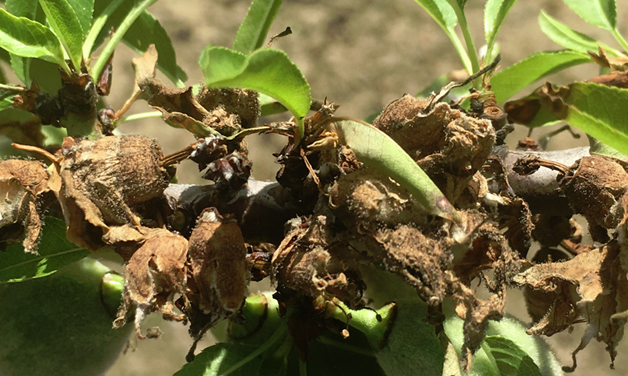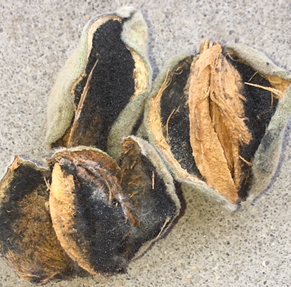
Reducing dust in almond orchards for mite control has been a common practice. Roads are watered, graveled or chemically treated to reduce dust. Decreasing vehicle speed is also recommended to minimize orchard dust.
But mowing may be another culprit to kicking up dust in orchards, and at certain times of the year, may contribute to increased disease.
Mites and Dust Control
Mowing, or any type of cultural activity requiring equipment within the orchard, will generate dust, according to Wes Asai, an almond grower and owner of Wes Asai Pomology Consulting in Turlock, Calif.
“It’s that repetitive, heavy dust that usually is associated with driveways and canal banks and things of that sort that tend to just repeatedly, day-after-day, concentrate dust very thick on the foliage,” Asai said, adding that the perimeter of the orchard is where it tends to be an issue.
“If for some reason in an orchard someone was always mowing and cultivating and landplaning and doing a lot of dirt manipulation, that would kick up a lot of dust. But typically within the interior of the orchard there’s less traffic and cultural activity,” Asai said.
Even if a grower is mowing every six weeks, that doesn’t compare to pickups driving on the canal bank 10 times a day, seven days a week. “That’s a lot more dust, on a more concentrated area along the perimeter. That’s the reason why usually roads and banks and things of that sort are associated with mite outbreaks,” Asai said.
While the primary concern for dust is causing mite problems, there are some other secondary things, particularly during critical stages of growth, where dust from mowing can be problematic. Mowing at bloom and hull split can potentially atomize spores of different fungi that can cause the disease problems, Asai said.
Structuring and timing cultural practices to avoid mowing at full bloom or the beginning of hull split can be beneficial, Asai said.
Mowing and Diseases
Mowing during the bloom period could increase problems with brown rot and jacket rot, Asai said.
Jacket rot kills flowers and small nuts, reducing yield potential, according to Franz Niederholzer, UCCE orchard systems farm advisor for Colusa, Sutter and Yuba counties.
“I’m not aware of jacket rot damaging bearing wood damage, spur death, things like that, but especially in a wet, cool spring, which is when jacket rot really gets going, it’ll spread through whole flower clusters and can be very damaging,” Niederholzer said.
With brown rot, the fungus survives in twig cankers and on diseased flowers and spurs. Spore pads provide inoculum for spring infection, and the spores are airborne or rain splashed.
Dry years with high humidity and dew events have had problems with brown rot as well.
Mowing during hull split could increase problems with hull rot. It can be caused by three pathogens: Rhizopus stolonifer, Monilinia spp., and, more rarely, Aspergillus niger.
Hull rot can cause significant yield loss, increased sanitation costs and potential lost yield in future years. “It gets you everywhere it can be had,” Niederholzer said.
Hull rot will cause the infected nut to stick to the tree. “They don’t shake off, you don’t harvest them, they don’t go in the windrow and they don’t contribute to your yield,” Niederholzer said, adding when the nuts stay on the tree, it also increases costs for winter sanitation.
“Hull rot pathogens produce toxins that kill the spur and sometimes whole shoots, so you’re losing your bearing surface,” Niederholzer continued.

Time Your Mowing
Full bloom is approximately the third week of February on average in California, and mowing a week to 10 days prior to this should last at least a month before it needs to be mowed again, Asai said.
“If you were to time it properly, there’s a pretty good window of opportunity that would necessitate not having to mow during that open bloom period,” Asai said, adding ideally, it’s that open bloom period to try and avoid mowing.
“It’s those bloom diseases that are the real critical ones to avoid,” Asai said.
On average, in Central California, hull split usually begins around the first week of July, so mowing prior to the initiation of hull split will help reduce issues with hull rot.
Dr. Jim Adaskaveg, professor of plant pathology at UC Riverside, did research on mowing and hull rot. His finding was: don’t make dust.
Your ground cover should be mowed in advance of hull split,” Adaskaveg said. He even went so far as to say, “make herbicide applications rather than mow in the month of June. In other words, you can mow up until May, but in June you want to reduce the dust by only doing chemical weed control,” Adaskaveg said.
Adaskaveg explained that the problem is that the hull rot-causing pathogens, Rhizopus stolonifer and Aspergillus niger, live in the soil. “Dust contains spores of these fungal pathogens and they end up on the fruit,” Adaskaveg said, adding that, “mowing during this time period helps the dissemination of the pathogen when the fruit begin to split.”
Adaskaveg’s recommendation is, “Don’t create dust by mowing in the month of June. Mow in April and May, and if additional preparation for harvest is needed, don’t physically mow because it creates too much dust,” he said.
Adaskaveg hasn’t done specific work at bloom because if a preemergent was applied in the fall, there is usually very little growth of the ground cover at bloom, but he agrees with Asai, “Any time you start mowing, you can potentially cause airborne dust and you have the potential of assisting in the dissemination of spores of different types of pathogens.”
For instance, Botrytis at bloom grows in the dead organic matter on the ground. “Any time you create dust with debris flying around from mowing, you are going to potentially increase the inoculum levels of pathogens at those critical host stages like during bloom or suture split,” Adaskaveg said. “You really do not want to be creating a significant amount of dust in the air during very critical times of tree susceptibility to disease.”
Other Considerations
Rodent control also helps reduce dust in the orchard. In particular, gopher mounds, when mowed, send up clouds of dust.
“You might be set just right for a nice, smooth orchard floor, but you run into a gopher mound every once in a while. They’re wildcards in there, and they can throw up quite a bit of dust when you hit a gopher mound,” Niederholzer said.
Squirrels are generally more in the berms, but the gophers can do quite a bit of mounding in the middles, Niederholzer said, adding gopher management is an important part of a dust control program.
For growers with full coverage irrigation, another option is to synchronize irrigation with mowing. After irrigation, wait a few days—long enough to avoid causing compaction problems—then mow while there’s still moisture on the foliage and in the ground.
“You’re less likely to create a big cloud of dust than if it were totally dry when you mowed,” Asai said.
“It’s not a do or die thing where you’re doomed to failure if you did mow. It’s just that if you can create a situation where you don’t have to do it during that most vulnerable period, that would be more desirable,” Asai said.










